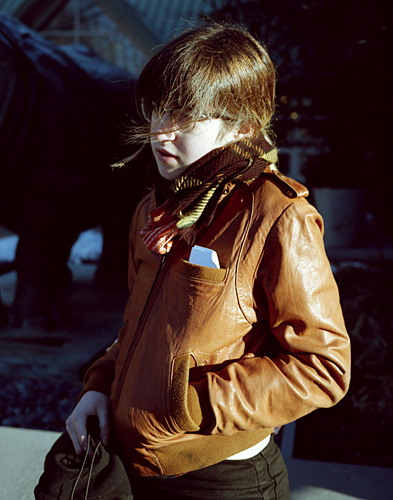Seasonal Wardrobe Re-invention Tactics
Since I live in climate where seasons vary greatly (New England), I have my entire wardrobe divided into two camps: Fall/Winter and Spring/Summer. I find that not only does a seasonal wardrobe keep my closet uncluttered, but it also keeps things exciting. It is such a joy to bust out fresh, exciting clothes for riding valiantly (via bicycle) into the springtime sun as well as pulling out all my winter cozies as soon as the first crisp breezes grace my skin. Dressing seasonally can give you an appreciation for nature unlike one you have had before; A relationship to the weather that makes it feel like your friend and not your foe.


This spring (or fall) cleaning process also serves to remind us that not only do the seasons change every year, but we change as well. The are philosophies that suggest that one should have a capsule wardrobe consisting of basic things that you can wear for the rest of your life. While I agree that it makes sense for everyone to have a 'little black dress' or a go-to pair of jeans/dungarees (I have one and I rarely wear pants) that we will inevitably wear until they disintegrate (over the course of a decade, if we're lucky), the kinds of things we like to adorn ourselves with will change fluidly as we do. This can take the form of anything from an intentional change of identity that requires a whole new style to activate, to starting a new job that requires certain kinds of garments. Moving to a new city with a different climate or lifestyle can also create a need for an altered wardrobe. We, as humans, are constantly changing, growing, and evolving. Fashion does play into this heavily, providing different items each season to appease our appetites for sartorial change.
It's completely okay to want different clothes each season. What I propose is to adhere to the following regimen, which blends the enlightenment of a limited wardrobe with a thoughtful and savvy approach to seasonal shopping.
1 - Figure out your basics Love wearing jeans? Find yourself in a casual blazer every time fall comes around? Love black cardigans? Live in ribbed tank tops? Figure out the kinds of things that you will love forever and invest in good ones. If you plan it well, you can buy one or two pair of jeans and a couple shirts every few years and they will serve you well. My basics are: camisoles, black jeans, button up shirts, cotton cardigans for summer and wool for winter, tights, and a few simple dresses.
2 - Adjust your other pieces according to your current tastes Last summer I was really into crop tops and shorts. This summer, I want to wear maxi skirts. There are pieces in our wardrobe that serve a more ephemeral purpose. Instead of practicing self-deprivation, allow yourself to indulge in a few new pieces a season (things that work with your basics). Go into the purchase with the idea that these items may be a summer fling and not a one night stand. Enjoy your short love affair with these pieces, don't purchase them irrationally out of a desire to buy something new or trendy. Since you know these items may serve a short stint, opt to purchase them from thrift stores, consignment shops, vintage stores, independent designers or make them from old clothes (don't be afraid to get crafty!). One caveat: Under no circumstances is this an excuse to buy cheap clothes from big chain stores with questionable labor practices and environmental standards. While this may be, arguably, the 'only option' for some in satisfying changing tastes, these 'fast fashion' items have a big social and environmental cost of offset their cheap price. Wherever you get your of-the-moment pieces, be responsible about what you do with these items when your love affair is over. Donate these clothes to thrift stores or, if you want to create a semi-sustainable seasonal clothing buying practice, resell items at places like Buffalo Exchange. Pass items on to friends or have clothing swaps to find new items at no cost. Love your clothes, respect them, and they'll treat you well.
3 - Find a use for unworn and sentimental clothing Do you have multiple nostalgic tshirts you never wear that clog up your drawer? Or a sweater grandma gave you that you have yet to wear but can't bear to ditch? Often, the only viable solution is to do something creative with these items so that they get some use. Think of clothing as having a life force. If you don't use it, it will get depressed. Make your summer camp tshirts from 6th grade that don't fit you into reusable grocery bags, or turn grandma's goofy, itchy sweater into a funky throw pillow for your couch. Don't be afraid to get crafty! (and, if you're mostly concerned with not wasting perfectly good things, no sentimental value involved, old tshirts and socks make great cleaning rags.)
4 - Let yourself try out a few risky pieces Have a sequined jacket that you think is the coolest thing ever and have only worn, say, 2 times in the last 5 years? That's alright. It's great to have a few 'statement pieces' that you bust out on occasion. The key is to keep this flock small. Only let yourself have a few of these items, because having a whole closet full of sequined jackets you wear once a year will mostly just take up space. Also, hang onto crazy items only as long as you can still think of reasons to wear them. It helps to pick a set number of 'statement pieces', swapping old ones out for new when you come home with an experimental purpose. Like buying seasonal items, the recycling and swapping of non-basic pieces is part of a sustainable shopping practice; One that is responsible, ethical, and allows you the freedom to change your style as your life dictates.
Good luck. More thoughts on wardrobe editing to come...
